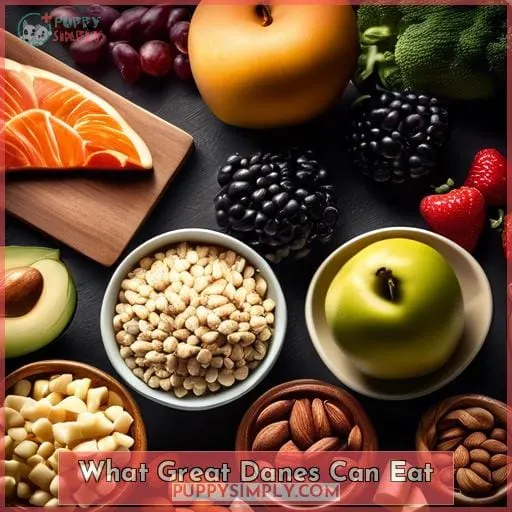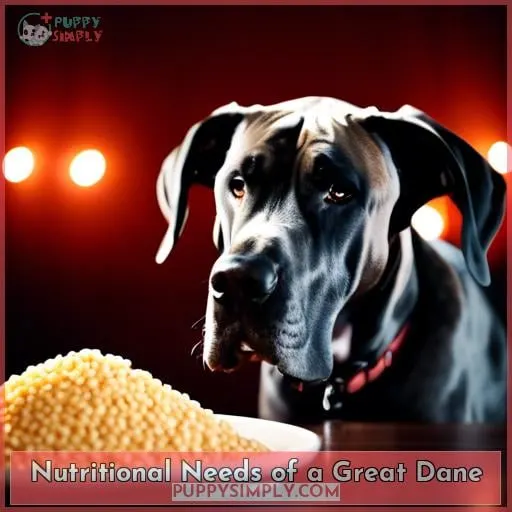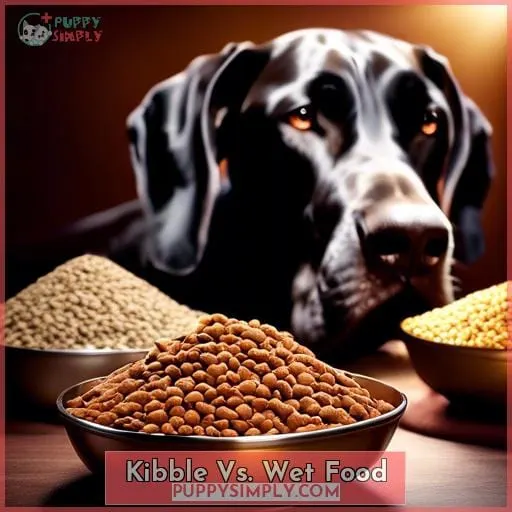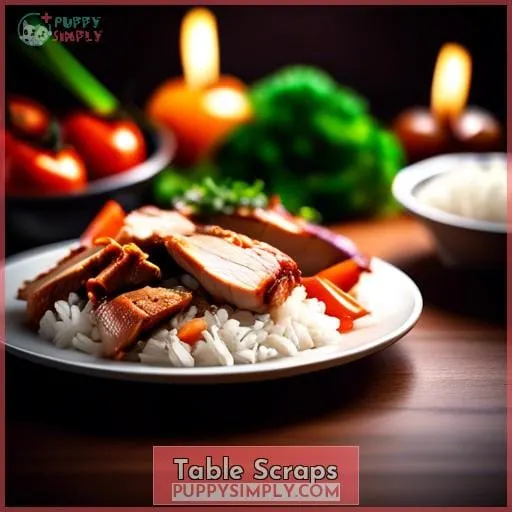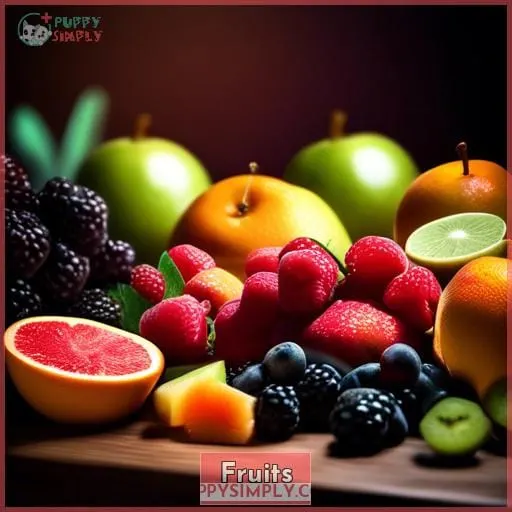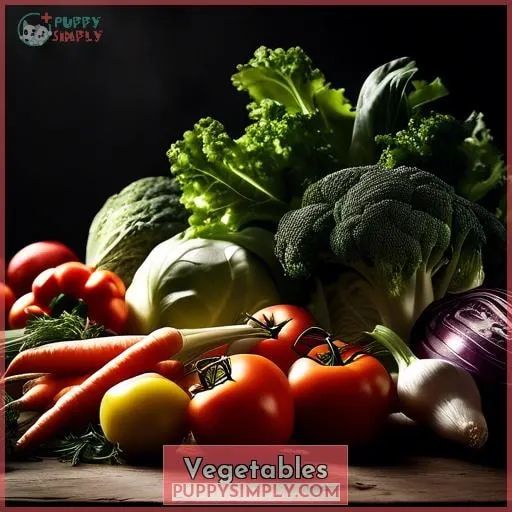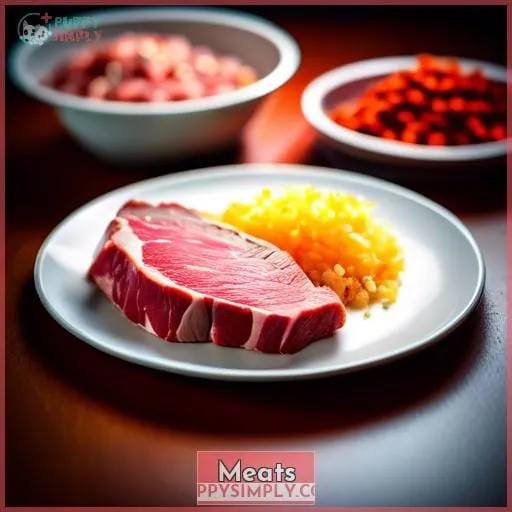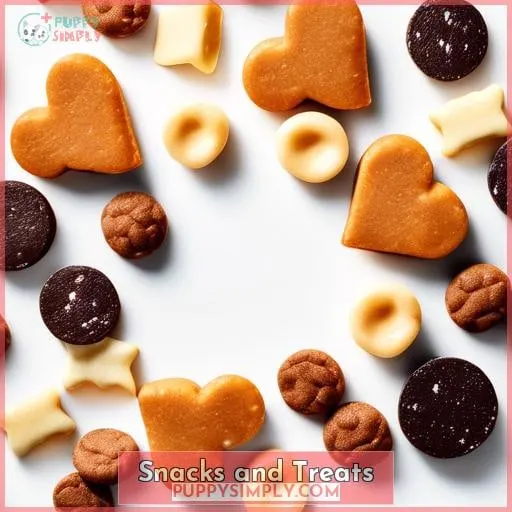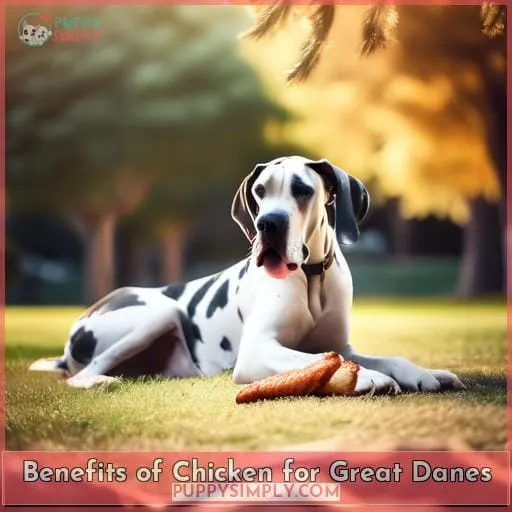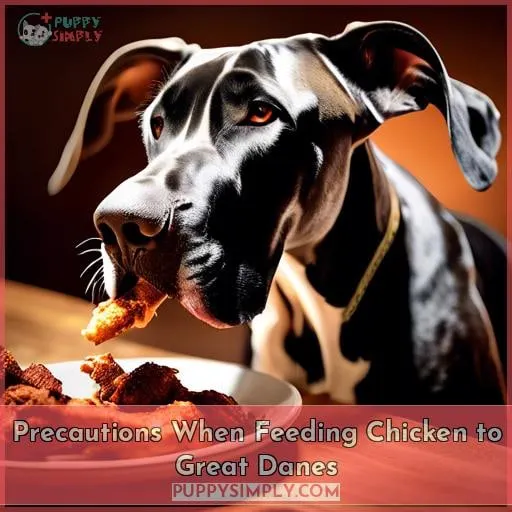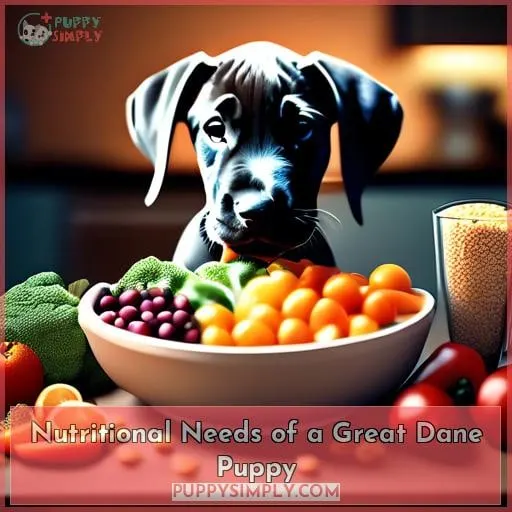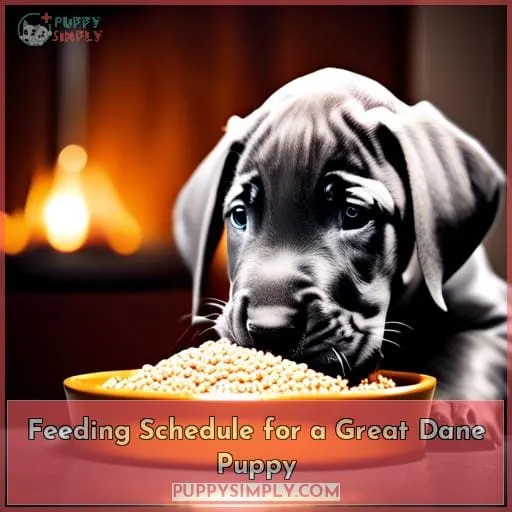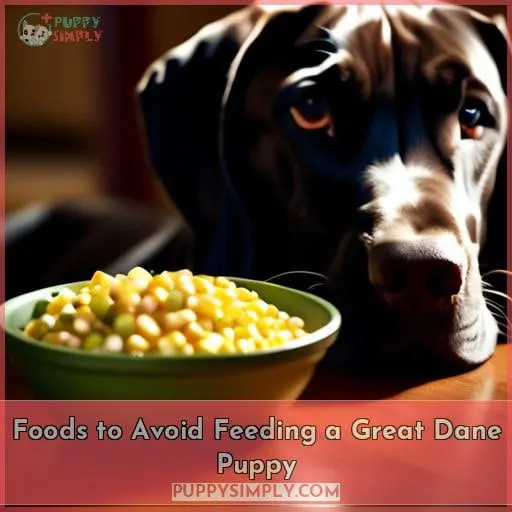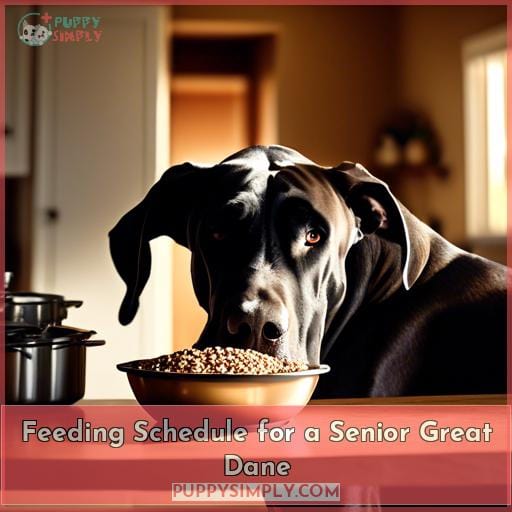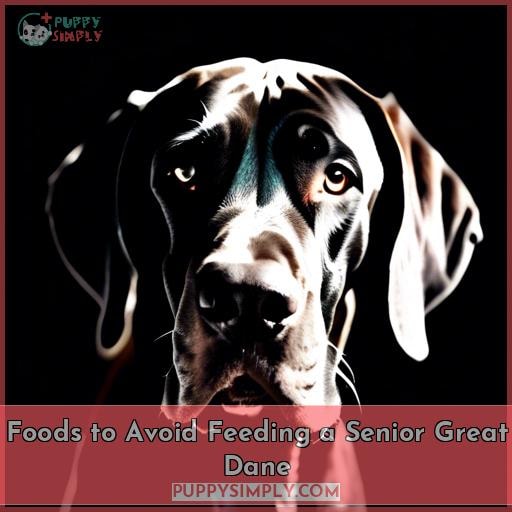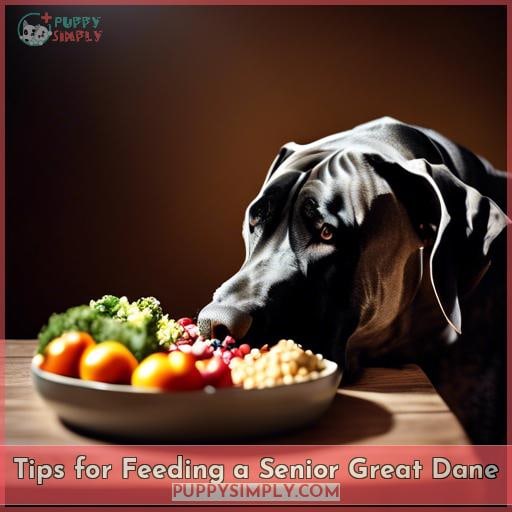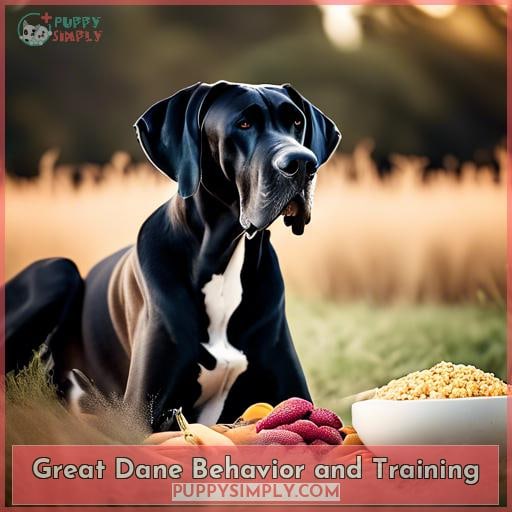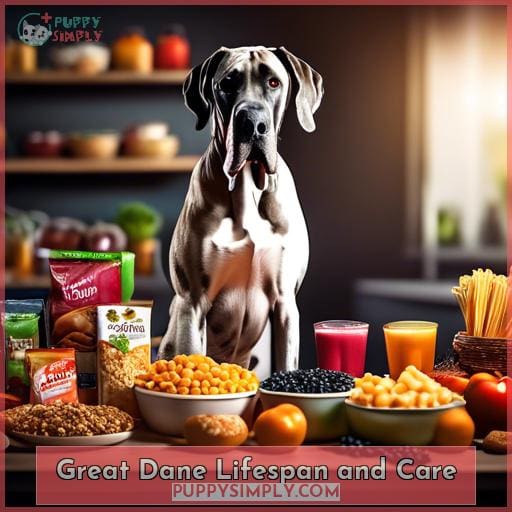This site is supported by our readers. We may earn a commission, at no cost to you, if you purchase through links.
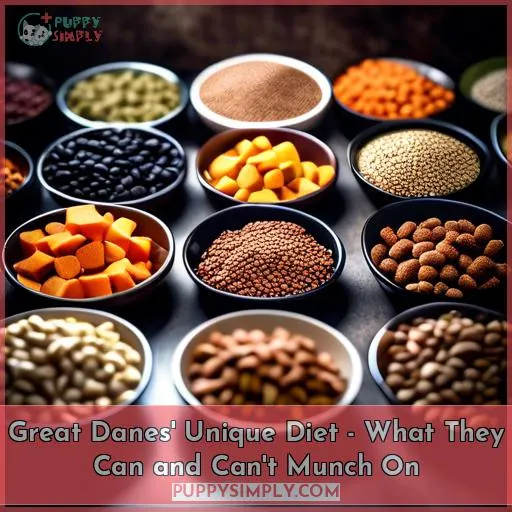 Uncover the secrets of a Great Dane’s unique diet and discover what they can and can’t munch on.
Uncover the secrets of a Great Dane’s unique diet and discover what they can and can’t munch on.
As a Great Dane owner, ensuring your gentle giant’s health and happiness is paramount.
Delve into the world of Great Dane nutrition and learn the essential dos and don’ts of feeding your beloved companion to keep them thriving and full of life.
Dos:
- Feed your Great Dane a high-quality diet that is specifically formulated for large breed dogs.
- Provide your Great Dane with plenty of fresh water at all times.
- Feed your Great Dane two to three meals per day, rather than one large meal.
- Avoid feeding your Great Dane table scraps or other human food.
-
Make sure your Great Dane has access to a safe and secure place to eat.
Don’ts:
- Do not feed your Great Dane a diet that is high in fat or protein.
- Do not feed your Great Dane any food that contains onions, garlic, or grapes.
- Do not feed your Great Dane any food that is spoiled or moldy.
- Do not feed your Great Dane any food that is too hot or too cold.
- Do not feed your Great Dane any food that is too hard or too chewy.
Table Of Contents
- Key Takeaways
- What Great Danes Can Eat
- What Great Danes Can’t Eat
- Nutritional Needs of a Great Dane
- Kibble Vs. Wet Food
- Table Scraps
- Fruits
- Vegetables
- Meats
- Snacks and Treats
- The Do-Not-Feed List
- Can Great Danes Eat Chicken?
- Benefits of Chicken for Great Danes
- Precautions When Feeding Chicken to Great Danes
- Commercial Dog Foods With Chicken
- Nutritional Needs of a Great Dane Puppy
- Feeding Schedule for a Great Dane Puppy
- What to Feed a Great Dane Puppy
- Foods to Avoid Feeding a Great Dane Puppy
- Tips for Feeding a Great Dane Puppy
- Nutritional Needs of a Senior Great Dane
- Feeding Schedule for a Senior Great Dane
- What to Feed a Senior Great Dane
- Foods to Avoid Feeding a Senior Great Dane
- Tips for Feeding a Senior Great Dane
- Great Dane Health Issues
- Great Dane Behavior and Training
- Great Dane Grooming
- Great Dane Exercise
- Great Dane Lifespan and Care
- Frequently Asked Questions (FAQs)
- Conclusion
Key Takeaways
- Great Danes should eat high-quality large-breed dog food, ample fresh water, and 2-3 meals daily.
- Avoid high-fat or high-protein diets, foods containing onions, garlic, or grapes, spoiled or moldy food, food that is too hot or too cold, and food that is too hard or too chewy.
- Great Danes can eat fruits like apples, oranges, bananas, and berries; vegetables like carrots, green beans, and broccoli; lean meats like chicken, beef, pork, lamb, and liver; and homemade meals using these ingredients.
- Avoid chocolate, avocados, macadamia nuts, alcohol, and tea.
What Great Danes Can Eat
Starting with fruits, you’re giving your Great Dane a healthy source of vitamins A, C, and K.
Apples, oranges, bananas, and berries are all great choices.
Just remember to remove peels, pits, rinds, and seeds.
Vegetables like carrots, green beans, and broccoli are also packed with potassium, protein, vitamin A, and folic acid.
Don’t forget about lean meats like chicken, beef, pork, lamb, and liver.
Remove all fat and bones before serving.
And if you’re feeling adventurous, you can even prepare homemade meals for your Great Dane using these ingredients.
Just be sure to do your research and make sure you’re providing a balanced diet.
What Great Danes Can’t Eat
Watch out for chocolate, avocados, macadamia nuts, alcohol, and tea, as they’re toxic to Great Danes.
Remember these forbidden foods, and keep them far away from your beloved pooch.
- Chocolate: This sweet treat contains theobromine, a stimulant that can cause heart problems, seizures, and even death in dogs.
- Avocados: The leaves, fruit, and seeds of avocados contain persin, a toxin that can cause vomiting, diarrhea, and respiratory distress in dogs.
- Macadamia nuts: These nuts can cause weakness, tremors, and vomiting in dogs.
- Alcohol: Alcohol can cause intoxication, respiratory depression, and even death in dogs.
- Tea: Tea contains caffeine, which can cause anxiety, hyperactivity, and heart problems in dogs.
By avoiding these toxic treats, you can help keep your Great Dane healthy and happy.
Nutritional Needs of a Great Dane
Your Great Dane’s nutritional journey begins with understanding their daily caloric needs.
An average adult gulps down 2,500 calories daily. Protein and fat are their fuel sources, so aim for a diet with at least 23% protein and 12% fat.
Don’t fall for cheap, low-quality dog food; invest in a better brand.
Puppies don’t need extra food to grow faster.
Avoid homemade meals unless a vet recommends them.
Dietary supplements are also unnecessary unless there’s a specific health concern.
Rich diets lead to obesity and joint issues.
Large breed formulas cater to their unique needs, while sensitive stomach formulas are gentler on their tummies.
Feeding challenges? Consult a vet or pet nutritionist.
Kibble Vs. Wet Food
With nutritional needs in mind, let’s compare the advantages and disadvantages of kibble and wet food.
Kibble:
- Required to be balanced and meet nutritional needs
- Promotes healthier gums and reduced dental plaque
- Easy to store and cost-effective
Wet Food:
- Made with fewer carbohydrates
- Easier to chew and its meat ingredients are closer to their natural state
- Good source of hydration
- Suitable option for sick dogs, those with poorly aligned jaws, or smaller mouths
Ultimately, the choice between kibble and wet food depends on your Great Dane’s individual needs and preferences. Consider factors like texture preferences, hydration benefits, dental health, and palatability factors when making your decision.
Table Scraps
Now, let’s venture into the realm of table scraps – those irresistible morsels that can add a burst of flavor to your Great Dane’s meals. Remember, moderation is key, and always consult your vet before introducing new foods.
Fruits:
- Apples
- Oranges
- Bananas
- Berries
Vegetables:
- Carrots
- Green beans
- Spinach
- Broccoli
Meats:
- Chicken
- Beef
- Pork
- Lamb
Snacks and Treats:
- Fruits
- Vegetables
- Peanut butter
- Oatmeal
Fruits, like apples and bananas, offer a vitamin-packed punch. Just remember to remove peels, pits, and seeds. Veggies, such as carrots and broccoli, provide essential nutrients. Meats like chicken, beef, and pork are protein powerhouses, but remove all fat and bones.
For snacks, offer fruits or veggies, and limit sugar and seasoning. Remember, a balanced diet is key to a happy and healthy Great Dane.
Fruits
Because fruits are a good source of vitamins A, C, and K, you can give your Great Dane fruit as a treat. Just be sure to feed only the fruit, not the peels, pits, rinds, or seeds.
Seasonal Fruit Selection:
Offer your Great Dane fresh, ripe fruits that are in season. This will ensure they’re getting the best nutritional value and flavor.
Frozen Fruit Treats:
Puree fruits and freeze them in ice cube trays or molds for a refreshing summer snack. You can also make popsicles by freezing fruit juice in molds.
Fruit Salad Ideas:
Create a fruit salad with a variety of fruits that your Great Dane will enjoy. Just be sure to avoid grapes, raisins, and currants, which can be toxic to dogs.
Vegetables
Next up on the menu, let’s explore the veggie options that’ll keep your Great Dane’s diet on track!
Veggies provide a treasure trove of potassium, protein, vitamin A, and folic acid. You can boil, steam, or roast them, but avoid adding any seasonings that could upset your dog’s tummy.
Just like with any food, keep an eye out for allergies. If you notice any concerning signs, don’t hesitate to consult your vet.
Meats
Great Danes can also enjoy lean cuts of meat, like chicken, beef, pork, lamb, or liver, after you remove all fat and bones.
Cooking methods matter: boil or grill the meat, and never season it. Seasonings like garlic, onions, and certain spices are toxic to dogs. Monitor your Great Dane for signs of an allergic reaction to any meat. If you notice any adverse symptoms, consult your veterinarian.
Commercial dog foods with chicken are available, but check the label to ensure chicken or chicken meal is the primary ingredient.
Your Great Dane needs a balanced diet, so don’t let meat be their only food source.
Snacks and Treats
Now that you’ve got the scoop on meats, let’s dive into the tasty world of snacks and treats for your Great Dane.
Fruits and veggies make healthy treats. Just remove pits, seeds, and rinds.
For homemade options, whip up frozen fruit and yogurt pops or blend some veggie and fruit purees into ice cube trays.
Training rewards should be small, tasty, and low-calorie.
Store-bought treats are fine, but watch out for excessive sugar and seasonings.
Dental chews help keep your Great Dane’s pearly whites sparkling.
Choose chews approved by the Veterinary Oral Health Council (VOHC).
Frozen delights are refreshing treats on hot days.
Freeze some bone broth or blend some fruits and yogurt, then freeze in molds.
Keep a lookout for healthy, homemade recipes online or consult your vet for personalized treat suggestions.
The Do-Not-Feed List
You’ll want to keep your Great Dane away from grapes, raisins, onions, garlic, and macadamia nuts.
These seemingly ordinary items are unsafe ingredients, forbidden treats, and dangerous substances to your beloved canine companion.
Even in tiny quantities, these harmful foods can trigger health issues, ranging from mild discomfort to life-threatening emergencies.
Grapes and raisins, for instance, can cause kidney failure.
Onions and garlic, whether raw or cooked, can lead to anemia.
Macadamia nuts, on the other hand, can cause weakness, vomiting, and tremors.
It’s crucial to be vigilant and keep these toxic items out of your Great Dane’s reach, ensuring their well-being and preventing any potential harm.
Can Great Danes Eat Chicken?
When it comes to chicken, you can absolutely offer your Great Dane a bite.
It’s a prevalent ingredient in commercial dog foods, and its high protein content and palatability make it appealing to dogs.
Chicken is a superb protein source, rich in essential amino acids for muscle development and maintenance.
It’s also packed with vitamins like B6 and niacin, and minerals like phosphorus and selenium, supporting various body functions.
Plus, lean chicken cuts are suitable for weight management.
Benefits of Chicken for Great Danes
Chicken’s protein is top-notch for your Great Dane’s muscles.
It’s lean and mean, helping them stay trim.
Not only that, but it’s chock-full of vitamins and minerals to keep your furry friend fit and fabulous.
High-Quality Protein Source
Chicken’s high-quality protein provides essential amino acids that support your Great Dane’s muscle building and maintenance.
High-protein diets are crucial for muscle development and maintenance.
Ensure your Great Dane’s dietary protein intake meets their needs.
Protein-rich foods like chicken help satisfy their protein requirements.
Low-Fat for Weight Management
Providing lean chicken cuts to your Great Dane can help with weight management by reducing their fat intake.
Low-fat treats like chicken can help your Great Dane maintain a healthy weight.
Lean protein in chicken aids in building and maintaining muscle mass.
Substituting high-fat treats with lean protein options promotes weight control.
Dietary balance is crucial, so don’t make chicken their sole food source.
Explore healthier options like boiled or grilled chicken to satisfy cravings.
Rich in Vitamins and Minerals
You’ll find a bunch of vitamins and minerals in chicken, like phosphorus, selenium, niacin, and vitamin B6, to support your Great Dane’s overall health.
| Mineral | Benefit | Example |
|---|---|---|
| Phosphorus | Strong bones and teeth | Energy production |
| Selenium | Antioxidant protection | Thyroid hormone metabolism |
| Niacin | Healthy skin and coat | Nervous system function |
| Vitamin B6 | Protein metabolism | Red blood cell production |
Treat your Great Dane to a diet rich in variety and packed with essential nutrients, and he’ll reward you with a happy, healthy life.
Precautions When Feeding Chicken to Great Danes
Now, let’s delve into some crucial precautions you must take when introducing chicken to your Great Dane’s diet.
First and foremost, ensure it’s cooked thoroughly. Raw chicken harbors bacteria that can make your furry friend quite sick.
Next, be vigilant about removing all bones from the chicken. They can splinter and cause blockages in your dog’s digestive tract, leading to severe health complications. It’s also best to avoid seasoned chicken, as garlic, onions, and certain spices are toxic to dogs.
Keep an eye out for any signs of allergy. Some Great Danes may be sensitive to chicken, exhibiting symptoms like itchy skin, excessive scratching, and digestive upset.
Finally, remember that moderation is key. While chicken is a nutritious treat, it shouldn’t be the sole source of your Great Dane’s diet. Provide a well-rounded meal plan that includes high-quality kibble, wet food, and other healthy options to ensure your canine companion thrives.
Commercial Dog Foods With Chicken
Your Great Dane’s chicken diet should include commercial dog foods that list chicken or chicken meal as a primary ingredient.
Scrutinize the label, avoiding foods with unnecessary fillers that can compromise nutritional balance.
Consider large breed formulas designed for your Great Dane’s unique needs, often including joint-supporting ingredients like glucosamine.
Palatability factors play a role in your Great Dane’s dietary preferences.
Look for dog food with a high meat content and limited use of plant-based ingredients.
Consider rotating different protein sources to keep your Great Dane interested and ensure they’re getting a variety of nutrients.
Nutritional Needs of a Great Dane Puppy
In raising a Great Dane puppy, you’ll need to provide a diet rich in nutrients to support its rapid growth and development.
These large pups need more calories and specific nutrients than adult dogs.
Focus on high-quality puppy food formulated for large breeds.
Look for options rich in protein (22-24%) for muscle development and healthy fats (12-15%) for energy.
Calcium and phosphorus are crucial for bone growth, while DHA supports brain development.
Monitor your puppy’s growth and adjust portions accordingly.
Keep an eye on their weight and body condition, ensuring they reach developmental milestones without becoming overweight.
Consult your vet for personalized dietary guidance.
Feeding Schedule for a Great Dane Puppy
Map out a consistent feeding schedule:
- Divide your Great Dane’s daily food intake into 2-3 smaller meals.
- This prevents stomach upset, promotes healthy digestion, and helps maintain a steady energy level throughout the day.
- Stick to specific mealtimes and avoid free-feeding, which can lead to overeating and weight gain.
Monitor your puppy’s growth closely:
- Great Dane puppies grow rapidly, so it’s crucial to ensure they’re receiving adequate nutrition to support their development.
- Keep an eye on their weight, body condition, and overall health.
- Consult your veterinarian if you have any concerns about your puppy’s growth or if they’re not gaining weight as expected.
Adjust the meal frequency and portion sizes as your puppy grows:
- Puppies need more frequent meals than adult dogs, so start with 3 meals per day and gradually transition to 2 meals per day as they reach adulthood.
- Adjust the portion sizes based on your puppy’s age, weight, and activity level to prevent overfeeding or underfeeding.
Make dietary adjustments based on your puppy’s individual needs:
- Some puppies may have specific dietary requirements due to allergies, sensitivities, or health conditions.
- Consult your veterinarian to determine the best diet for your puppy and make necessary adjustments to ensure they’re receiving the nutrients they need.
What to Feed a Great Dane Puppy
To ensure your Great Dane puppy grows up healthy and strong, feed it a high-quality puppy food specifically designed for large breeds.
These formulas are tailored to support the unique growth phases of a Great Dane puppy, providing the right balance of nutrients for healthy bone and muscle development.
Look for a special puppy formula that contains the ideal calcium-to-phosphorus ratio for proper bone growth.
Be mindful of puppy food allergies, and if you notice any signs of an allergic reaction, consult your veterinarian immediately.
When choosing between kibble and wet food for your puppy, consider their individual needs and preferences.
Kibble helps promote healthy teeth and gums, while wet food can be easier for puppies to chew and digest.
Ultimately, the best diet for your Great Dane puppy is one that provides them with the nutrients they need to thrive while being palatable and easy to digest.
Foods to Avoid Feeding a Great Dane Puppy
Moving on to foods you must avoid feeding your Great Dane puppy:
- Avoid foods with too much fat, sugar, or salt.
- These can lead to allergic reactions and an upset stomach.
- Puppies have sensitive tummies, so sudden dietary changes are a big no-no.
Fatty foods:
- Excess fat can cause pancreatitis, a serious inflammation of the pancreas.
Sugary foods:
- Sugary foods can lead to weight gain and dental problems.
Salty foods:
- Salty foods can cause dehydration and electrolyte imbalances.
Raw meat or eggs:
- Raw meat and eggs can contain harmful bacteria, such as Salmonella and E. coli.
Avoid foods that can harm your puppy’s growth plates and bone development:
- Long bones, such as those from chicken or turkey, can splinter and cause internal injuries.
- Small bones, such as those from fish or rabbits, can be swallowed whole and cause choking or intestinal blockage.
- Knuckles are hard and can damage your puppy’s teeth.
Feed your puppy a diet that’s specifically designed for large breed puppies.
- These diets are formulated to meet the unique nutritional needs of growing puppies and help them achieve optimal weight.
Tips for Feeding a Great Dane Puppy
Tips for Feeding Your Great Dane Puppy
To nurture your Great Dane puppy’s health, follow these guidelines:
Manage Puppy Weight:
- Avoid overfeeding, as rapid growth can strain joints.
Adjust Feeding Schedule:
- Feed puppies 3-4 meals daily.
- Adjust portions to maintain a lean physique.
Introduce New Foods Gradually:
- Start with puppy-specific kibble.
- Introduce new foods one at a time to monitor for allergies.
Select Appropriate Treats:
- Choose low-calorie treats like carrot slices or apple chunks.
- Avoid sugary or fatty treats.
Monitor Calorie Intake:
- If your puppy is gaining weight too quickly, reduce daily calorie intake by 10%.
- Consult your vet if concerned.
Nutritional Needs of a Senior Great Dane
Senior Great Danes’ dietary requirements change, demanding an adjusted nutritional balance.
Age-related conditions like arthritis and hip dysplasia necessitate joint-supporting supplements like glucosamine and chondroitin.
Weight management becomes crucial to prevent obesity and its associated health risks.
Senior dogs may also experience dental issues, so a diet promoting dental hygiene is essential.
Opt for high-quality senior dog food formulated with these specific needs in mind.
Look for ingredients like omega-3 fatty acids, antioxidants, and probiotics.
Avoid foods with excessive fillers and low-quality ingredients.
You can also incorporate fresh, human-grade foods into their diet, such as lean protein sources, fruits, and vegetables.
Feeding Schedule for a Senior Great Dane
As your Great Dane gracefully enters its senior years, you’ll want to adjust its diet to support its changing health needs.
Senior Great Danes often have a slower metabolism, making weight management crucial.
We recommend dividing their daily food into two or three smaller meals to prevent overeating and promote better digestion.
Senior dogs are also prone to dental problems, so consider feeding them wet food or kibble designed to support dental health.
Joint supplements and a diet rich in omega-3 fatty acids can help ease joint pain and promote mobility.
Ensure they stay hydrated by providing fresh water throughout the day and consider adding water to their food.
What to Feed a Senior Great Dane
Your senior Great Dane’s diet should consist of high-quality, easily digestible food that meets their specific nutritional needs.
Senior dog food options are available that are tailored to their reduced activity levels and changing metabolism.
These formulas often contain a blend of high-quality protein, healthy fats, and digestible carbohydrates to support their overall health.
Nutritional supplements can also be beneficial for senior Great Danes.
Joint supplements, for instance, can help support their joint health and mobility.
Omega-3 fatty acids can promote healthy skin and coat, while probiotics can support digestive health.
Discuss with your veterinarian about the right supplements for your dog.
Dental health is also important for senior Great Danes.
Dental chews and regular teeth brushing can help prevent dental disease.
Weight management is another key consideration.
Senior Great Danes may be less active, so you might need to adjust their food intake to prevent weight gain.
Foods to Avoid Feeding a Senior Great Dane
Often, you’ll want to avoid giving your senior Great Dane foods that are high in fat or sugar, as these can exacerbate health issues.
For instance, fatty foods can worsen joint pain and contribute to weight gain, while sugary foods can lead to dental problems and potentially diabetes.
You should also avoid giving them bones, as these can splinter and cause internal injuries.
Additionally, it’s best to steer clear of foods that are high in salt, as excessive sodium can put a strain on their kidneys and heart.
Instead, opt for foods that are easy to digest and provide essential nutrients to support their aging bodies.
You can also consider feeding them a diet specifically designed for senior dogs, which often contains ingredients that promote joint health, cognitive function, and overall well-being.
Tips for Feeding a Senior Great Dane
To keep your senior Great Dane healthy, feed them small meals more frequently throughout the day.
Consider adding water to their food to make it easier to chew and digest. Senior dogs often have dental issues, so choose a kibble that’s easy on their teeth.
Joint supplements can help ease the pain of arthritis, a common problem in older dogs. If your Great Dane is overweight, talk to your vet about a weight loss plan. Obesity can lead to a number of health problems, including heart disease and diabetes.
Tip 1: Feed smaller meals more frequently.
Tip 2: Add water to their food.
Tip 3: Consider joint supplements.
Tip 4: Manage their weight.
Tip 5: Brush their teeth regularly.
Great Dane Health Issues
The health issues that commonly affect Great Danes include:
- Hip dysplasia
- Elbow dysplasia
- Bloat
Be mindful of their diet and exercise.
These gentle giants are also prone to:
- Allergies
- Joint pain
- Heart disease
You can help your Great Dane stay healthy and happy by:
- Feeding them a nutritious diet
- Providing them with plenty of exercise
If you notice any signs of illness in your Great Dane, such as:
- Limping
- Coughing
- Diarrhea
Take them to the vet right away.
Early diagnosis and treatment can help your dog live a long and healthy life.
Great Dane Behavior and Training
Next, you’ll learn how to best train your Great Dane to behave well.
Great Danes are intelligent and eager to please, making them responsive to training.
Begin obedience classes early, focusing on basic commands like sit, stay, and come.
With patience and positive reinforcement, your Great Dane will master these commands in no time.
Housebreaking is another essential aspect of training.
Establish a consistent routine, taking your Great Dane out frequently to the same spot.
Utilize positive reinforcement, such as treats and praise, when they go potty outside.
Accidents happen, so clean up messes thoroughly to prevent repeat offenses.
Leash training is crucial for safe walks.
Start by fitting your Great Dane with a comfortable harness.
Gradually introduce the leash, allowing them to get used to it indoors before venturing outside.
Begin with short walks, gradually increasing the duration as your Great Dane becomes more comfortable.
Crate training can provide your Great Dane with a safe and secure space.
Introduce the crate gradually, making it a positive experience by placing treats and toys inside.
Never use the crate as punishment, as this will create negative associations.
Socializing your Great Dane is vital for their well-being.
Expose them to various people, animals, and environments from an early age.
This will help them become well-adjusted and confident dogs.
Great Dane Grooming
Now that you’ve got your Great Dane’s diet dialed in, let’s move on to the few grooming tasks you’ll need to keep up with.
These gentle giants require a bit of TLC to keep their coats healthy and their nails trimmed.
Brushing their short, dense coats a few times a week will help remove dead hair and prevent mats.
You’ll also want to bathe your Great Dane every 8-12 weeks, or more often if they get dirty.
- Brush Regularly:
Regular brushing is essential for removing dirt, debris, and loose hair.
It also helps distribute natural oils throughout the coat, keeping it shiny and healthy.
- Trim Nails:
Keep your Great Dane’s nails trimmed to prevent them from getting too long and causing discomfort or injury.
Trim the nails every few weeks or as needed.
- Bathe Occasionally:
Great Danes don’t require frequent bathing, but you should give them a bath every 8-12 weeks, or more often if they get dirty.
Use a gentle shampoo and conditioner designed for dogs.
Great Dane Exercise
- To keep your Great Dane’s body and mind healthy, you’ll need to provide it with regular, vigorous exercise.
These gentle giants have high energy requirements and need plenty of opportunities to burn off steam.
Aim for at least 30 minutes of moderate exercise daily, but an hour or more is ideal.
Outdoor activities like running, hiking, or swimming are great options, as are indoor games like fetch or tug-of-war.
Socialization is also important for Great Danes, so consider enrolling your pup in a doggy daycare or taking it to the dog park.
A well-exercised Great Dane is a happy, healthy Great Dane.
Exercise Routine:
- Aim for at least 30 minutes of moderate exercise daily, with an hour or more being ideal.
- Include a variety of activities, such as running, hiking, swimming, fetch, and tug-of-war.
Energy Requirements:
- Great Danes have high energy requirements and need plenty of opportunities to burn off steam.
Outdoor Activities:
- Outdoor activities like running, hiking, or swimming are great options.
Indoor Games:
- Indoor games like fetch or tug-of-war are also good ways to exercise your Great Dane.
Socialization Needs:
- Socialization is also important for Great Danes, so consider enrolling your pup in a doggy daycare or taking it to the dog park.
Great Dane Lifespan and Care
Your Great Dane’s lifespan and care rely heavily on maintaining a balanced diet and healthy lifestyle.
They’re large dogs with life expectancies of 7 to 10 years, so providing proper nutrition and exercise is crucial.
Feed your Great Dane a high-quality diet that meets their nutritional needs and avoid table scraps.
Obesity can be a serious health issue for Great Danes, so ensure they get plenty of exercise to stay fit.
These gentle giants do well with daily walks and regular playtime.
Be mindful of their exercise requirements as they age, and provide them with appropriate activities that don’t strain their joints.
Regular vet checkups are essential to monitor their health and catch any potential issues early on.
With proper care and attention, you can give your Great Dane a long and happy life.
Frequently Asked Questions (FAQs)
How many meals a day should I feed my Great Dane puppy?
For optimal growth and development:
- Feed your Great Dane puppy three balanced meals daily until they’re about 6 months old.
- Then transition to two meals a day.
What human foods should I avoid giving my Great Dane?
Avoid feeding your Great Dane:
- Chocolate
- Avocados
- Macadamia nuts
- Onions
- Garlic
These foods can be toxic to dogs.
Grapes and raisins can also cause kidney failure, so keep those out of reach too.
What kind of snacks or treats are safe for Great Danes?
Treat your Great Dane to a symphony of healthy snacks:
- Fruits
- Veggies
- Cooked pasta
- White rice
- Occasional peanut butter (avoid sugar-free)
How can I tell if my Great Dane has a food allergy?
.
How much exercise does a Great Dane need daily?
Unlock the secret to keeping your Great Dane fit and happy:
Aim for 30-60 minutes of daily exercise.
Balance leisurely walks with energetic playtime.
Exercise not only strengthens muscles but also fuels their boundless spirit.
Conclusion
Out of all dog breeds, Great Danes are particularly prone to bloat, with a shocking 40% of them experiencing this life-threatening condition.
To safeguard your gentle giant, follow the comprehensive guidelines provided in this article on the ultimate guide to what Great Danes can and can’t eat.

